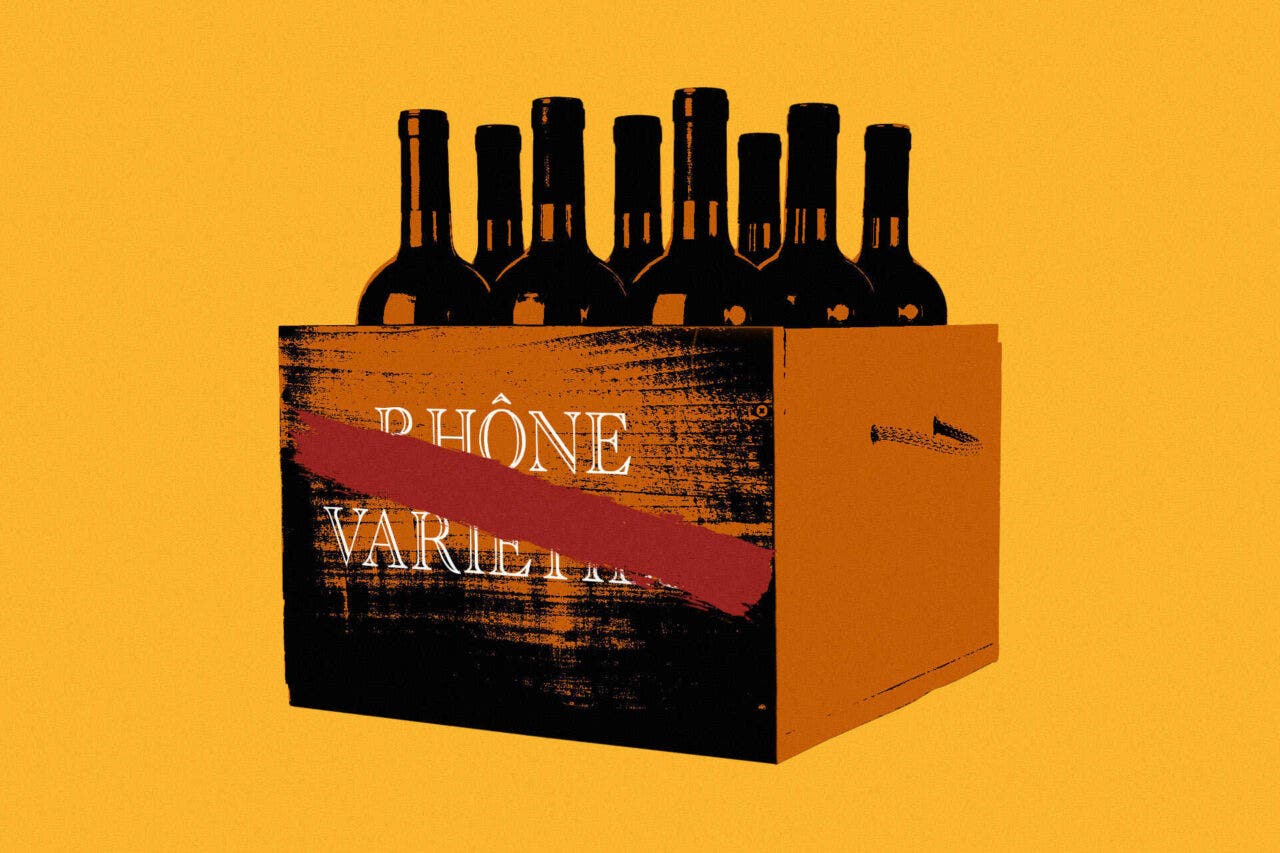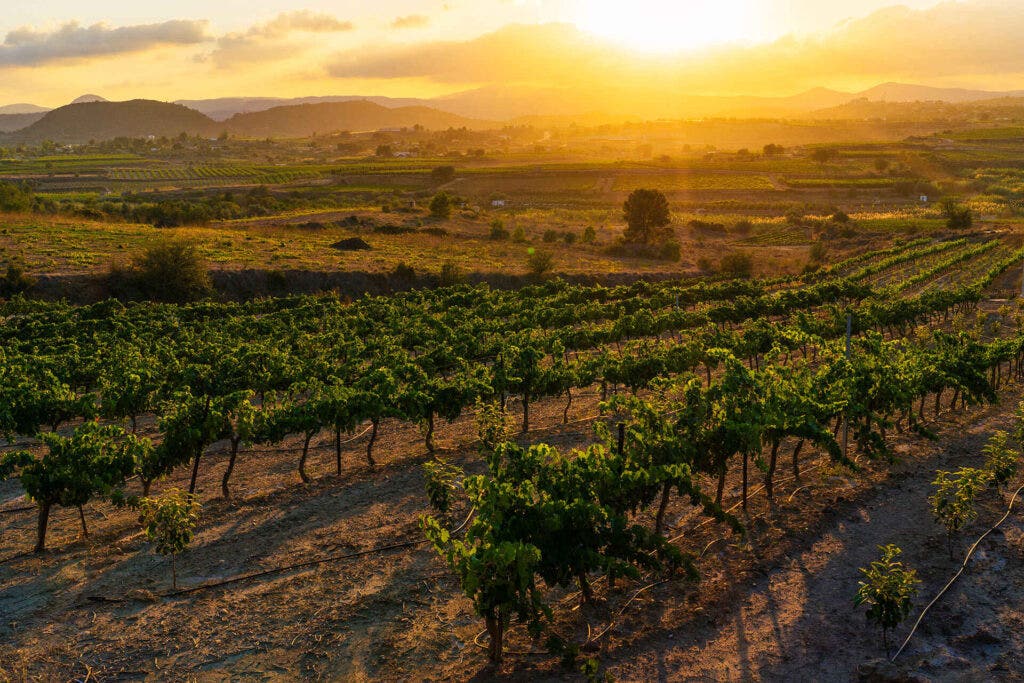Anyone who is vaguely versed in wine knows that when it comes to red grapes, “Rhône varieties” refers to Syrah, Grenache, Mourvèdre and Carignan. But what if these Rhône varieties are actually not from Rhône at all?
Historic and DNA evidence show that of the four varieties, only Syrah truly hails from the French side of the Pyrenees, the mountain range dividing France and Spain. The remaining three historically come from the Spanish side of the mountains. This means they should be better known internationally by their Spanish names—Garnacha, Monastrell and Cariñena or Mazuelo.
At Wine Enthusiast we are even guilty of using the grape’s French names instead of their Spanish ones. In fact, Spanish blends made with these grapes are currently filed under “Rhône-style blend,” in our database. However, that’s how the majority of consumers have come to refer to and search for these wines.
But we think it’s time to put this erroneous term to rest. Here’s a look at how the moniker “Rhône varieties” came to be, where these grapes actually originated and how we should label them moving forward.
Where Did the “Rhône Varieties” Moniker Come From?
In the encyclopedic book Wine Grapes, the authors list 1,368 wine grape varieties and present evidence for the geographic origins and parentage of each. To do this, they include DNA analysis and comprehensive research of the grapes’ existence in a particular region.
When asked why Garnacha, Monatrell and Cariñena (or Mazuelo) have become known globally by their French names, Jancis Robinson, MW, co-author of Wine Grapes, responds, “I think it’s just a hangover from the supposed supremacy of France in the wine sphere.”
Jose Vouillamoz, ampelographer and another co-author of Wine Grapes adds, “French wines have been the benchmark for fine wines for centuries. For this reason, emerging wine regions have often tried to imitate French wines.”
Anna-Christina Cabrales, tasting director at Wine Enthusiast, adds that the rise in popularity of Châteauneuf-du-Pape (a Rhône region) could have also encouraged the moniker, as the region is known for its Grenache-Syrah-Mourvèdre(GSM) blends.
“Asking for a GSM blend is a lot easier to pronounce than ‘Châteauneuf-du-Pape,’” says Cabrales.
The Real Origins of Rhône Varieties
Syrah can claim French heritage, according to Wine Grapes, but here’s where the other supposed Rhône varieties actually come from.
Spanish Garnacha vs. French Grenache
The third-most planted red grape in Spain, behind Tempranillo and Bobal, is Grenache—or rather, Garnacha as it’s known in Spain. It was first written about in Spain in 1513, when it appeared in Gabriel Alonso de Herrera’s Agricultura General, under the name Aragones—a synonym still in use today. In the late 18th century, it arrived in France, where it originally went by the name of the area in which it was first planted—Roussillon.
The real debate about the origin of Garnacha, however, is between Spain and Sardinia.
“There is a lot of ‘patriotism’ when it comes to pinpointing the place of origin of a well-known variety,” says Vouillamoz. “For example, Sardinians would love to see [the name] Cannonau [used] instead of Garnacha, because they are convinced that this [grape] originates from their island, which we do not support in Wine Grapes.”
From a genetic standpoint, Spain appears to be the birthplace of Garnacha because, according to Wine Grapes, “…all three-color variants (black, grey and white) as well as other morphological mutations …have been observed in Spain but not on Sardinia.” If a crop has a lot of diversity in a certain area (like how there are several color variants of Garnacha in Spain) it’s a widely held belief it likely originated there.
Additionally, Garnacha shares a genetic relationship with other Spanish varieties, such as Verdejo and Airén, making it seem likely it originated in Spain.
Other experts back this claim, too. For instance, Oz Clarke in his Encyclopedia of Grapes and Rosemary Radden in Grapes and Wines of the World, also supports the Spanish origin of Garnacha.
It is also accepted by myself and co-authors Jeff Jenssen and Kevin Zraly in Red Wine: The Comprehensive Guide to the 50 Essential Varieties and Styles. After all, as of 2017, Spain had about 185,000 acres of Grenacha, which was bested by France, where 200,000 acres existed.
In Red Wine, we explained that Spain’s Garnacha vineyards were predominantly in Castilla-La Mancha and Aragon and the plantations make up around 40% of all vines grown in Priorat.
In France, in addition to Châteauneuf-du-Pape, it is also the main grape in Gigondas and in Côtes du Rhône and Languedoc-Roussillon blends.
Garnacha is clearly an important grape on both sides of the border, but its origin on the Spanish/Catalan side supports the use of the Spanish rather than the French title.
Spanish Cariñena vs. French Carignan
Cariñena is “a native Spanish grape,” writes Karen MacNeil in The Wine Bible, noting how it is one of the most important varieties in Spain’s Priorat region that originated on the Spanish side of the border.
The grape known as Carignan in France primarily goes by two names in Spain: Mazuelo and Cariñena. The name Mazuelo comes from a village in Spain’s province, Burgos, called Mazuelo de Muñó. Cariñena is named for a town in Aragon, Spain.
That said, according to Wine Grapes, Carignan “has dozens of synonyms in Spain and in various European countries, suggesting it’s a very old variety that was dispersed a long time ago.”
Under the name Mazuelo, it is used as a blending grape in Rioja. It is also produced as a single-varietal Cariñena in Aragon and Catalonia.
But the majority of Carignan plantings are, in fact, in the Rhône Valley: France has nine times more of the variety than Spain does. However, that shouldn’t stop drinkers from thinking of it as a Spanish grape.
According to Red Wine, “Spain has substantial acreage of Cariñena in Catalonia and La Rioja as well as Navarre, Castilla-La Mancha and Aragon. Catalan vintners are making impressive wines from hundred-year-old bush vines that thrive in their soil.”
Despite France’s impressive plantings of the variety, this may change as the European Union (EU) has incentivized farmers to plant other varieties like Grenache, Syrah and Mourvèdre.
Spanish Monastrell vs. French Mourvèdre
Monastrell was mentioned in Catalonia as early as 1361 and was called “one of the most important grape varieties of the region of Valencia” in 1460, according to Wine Grapes, The Spanish moniker comes from the word for “monastery.” Meanwhile, even the French name of Mourvèdre has Spanish/Catalan roots. Mourvèdre is named for a town in Valencia, called Morvèdre in Catalan and Murviedro in Spanish.
Another internationally used name for Mourvèdre is Mataro, which is used in Australia and California. It is a town on the Mediterranean coast between Valencia and Barcelona. As the fourth-most planted red grape in Spain, it is mainly grown in Alicante, Jumilla, Valencia and Yecla.
“Monastrell most likely crossed the border from Spain into France sometime in the 16th century,” according to Red Wine. Adding that despite the loss of acreage to phylloxera in the late 19th and early 20th centuries, plantings have been on the rise in France for the last 50 years. As of 2017, France was home to 25,000 acres of the variety.
However, other than France’s Bandol Appellation d’Origine Contrôlée (AOC), Mourvèdre, as it’s known there, is mainly a blending component in GSM blends. Whereas in Spain, Monastrell “grows on almost 160,000 acres, making it one of the most widely planted grapes in Spain,” according to Red Wine. Today, wine shops and restaurants all over the world sell a wide variety of single-varietal Monastrell.
Changing the Moniker
Harding says, when she and her colleagues were writing Wine Grapes, “We had to choose a ‘prime name’ that would be used throughout the book and to manage all the cross-references. It seemed both logical and respectful to use the name in the country of origin.”
Perhaps it’s high time the rest of us did the same. So, the next time you hear someone talk about a GSM blend, remember it really stands for Garnacha-Syrah-Monastrell.
Last Updated: July 12, 2023

















